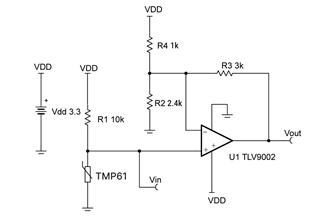Other Parts Discussed in Thread: TMP61, INA351, TLV9062
Hello TI E2E Community,
I am currently working on a temperature-sensing application using the TMP6131ELPGMQ1 linear thermistor from Texas Instruments. The TMP61 sensors are intended to be placed about 3m away from the STM32G474 microcontroller unit (MCU). The application calls for four temperature sensors, each connected to its own ADC channel on the MCU.
The ADC channels on the MCU can accept an input voltage swing from 0 to 3.3V or alternatively 0 to 2.048V/2.5V/2.9V with a 12-bit ADC resolution. We also have access to stable reference voltages of 2.048V, 2.5V, 2.9V, and 3.3V.
To maximize accuracy and utilize the ADC's dynamic range as effectively as possible, I'm considering using a non-inverting amplifier to increase the output voltage swing from the TMP61 sensor.
My question is: what would be the best approach in terms of designing this non-inverting amplifier? Also, should I use a voltage divider biasing network or an independent constant current source for the TMP61 sensor? Which one would offer greater accuracy?
If there are other ways to improve the signal chain, or if additional information about the system setup or constraints is needed, please let me know.
Thank you



